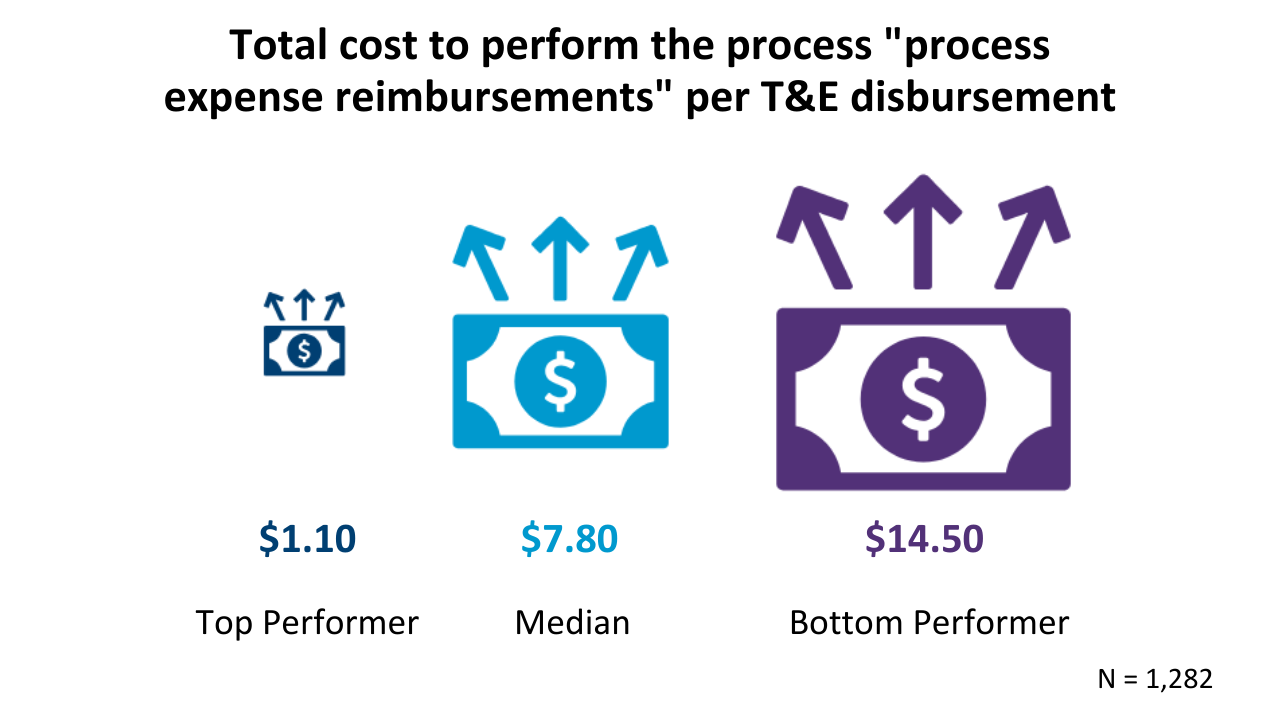
Business travel took a serious hit in 2020, dropping by an unprecedented 97%. As the world economy forges ahead in 2021, many experts anticipate an immediate spike in travel demand that will increase rates for airfare, hotels, restaurants, and rental cars.
It’s understandable if your travel and entertainment reimbursement process has gotten a bit dusty over the last year, but it’s critical to ensure this process is optimized for the coming crunch. This month, we’ll examine what organizations typically spend to process T&E reimbursements and review some best practices that can help keep costs for this process under control.
This month’s measure calculates the total cost per T&E disbursement to process reimbursements for expenses that employees incur during the course of business. It includes the cost of establishing and communicating expense reimbursement policies and approval limits; approving and processing advancements and reimbursements; capturing and reporting relevant tax data; and managing personnel accounts. The total cost reflects the sum of outsourced, overhead, personnel, systems, and other costs.
Through responses to APQC’s Accounts Payable and Expense Reimbursement Performance Assessment, we find that top performers on this measure spend $1.10 per T&E disbursement to process expense reimbursements. Bottom performers spend more than ten times that amount at $14.50. With travel picking back up, bottom-performing companies should endeavor to drive these costs down as much as possible.
Three Best Practices for T&E Reimbursement
There could be several reasons why an organization would find itself spending nearly $15 per reimbursement on this process. For example:
- If employees aren’t knowledgeable about how the reimbursement process works, accounts payable staff may have to spend time correcting mistakes or pursuing documentation.
- If an organization lacks a centralized place to upload and store documentation, then receipts and other relevant documents could be harder for staff to find.
- A manually-intensive process will also be more time-consuming for staff and thus more costly.
Leading companies avoid these pitfalls by following three key practices, which we discuss below.
Digitize and Automate the Process
T&E reimbursement is an ideal candidate for digitization and automation because the technology is widely available and the benefits are clear.
Products on the market are helping organizations optimize workflows within the process; enhance a company’s analytics capabilities to better manage costs; increase visibility into travel booking and authorized options; and more. Organizations are best served by a product that largely automates transactional steps in the process, provides digital capture of relevant documents, and provides notifications for needed deadlines and approvals. If your company is too small for a system like this to make sense for you, make sure that whatever system you do use is easy to understand for employees as well as the accounts payable staff.
Develop and Communicate Clear Policies
Even the best technology can’t fix a broken process. If employees aren’t clear on T&E policy or the process isn’t carried out consistently, digitization and automation will only accelerate those problems. For that reason, it’s important to implement strong governance and develop T&E policies that are clear and communicated to all employees.
An effective reimbursement policy is developed with input from multiple stakeholders including procurement, compliance/legal, HR, finance, auditing, and security. It’s also important to gain input from employees who regularly require reimbursement. The policy that results from discussions with these stakeholders should be clear, detailed, and enforceable, covering areas such as:
- Roles and accountability, including who authorizes reimbursements and enforces the policy
- Spending thresholds requiring pre-approval
- How to book travel
- How to make purchases (e.g., a corporate card)
- Expense report specifications (e.g., values requiring a receipt)
- Processes for exceptions and disputes
Policies for these areas should be easy for employees to access and understand. The reimbursement policy should also be well-communicated through training to employees and their managers so that no one has to guess what they should be doing when it comes time for reimbursement.
Monitor Process Performance
Benchmarking is one of the foundations of process improvement. It not only allows measurement of process performance over time but also allows organizations to see how their performance compares to organizations in the same industry or with similar characteristics. KPIs may vary by company type and industry, so APQC always recommends tracking a balanced set of KPIs that include productivity, cycle time, and efficiency measures. Along with the measure above, relevant measures for T&E expense reimbursement include:
- The number of T&E disbursements per T&E FTE (a productivity measure).
- Number of FTEs that process expense reimbursements per $1 billion revenue (an efficiency measure).
- Cycle time in days to approve and schedule T&E disbursements.
While COVID-19 put the brakes on business travel, it’s going to come roaring back to life soon. Don’t wait until AP is swamped with reimbursement requests to get your T&E reimbursement process in order. Automate where possible, work to ensure everyone is on the same page about how the process works, and measure the health of the process with a balanced set of KPIs to keep spending in line.


